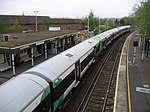Standen
1894 establishments in EnglandArts and Crafts architecture in EnglandCountry houses in West SussexEast GrinsteadGardens in West Sussex ... and 10 more
Grade I listed buildings in West SussexGrade I listed housesHistoric house museums in West SussexHouses completed in 1894Houses decorated by Morris & Co.National Trust properties in West SussexNature reserves in West SussexPhilip Webb buildingsUse British English from February 2023Victorian era

Standen is an Arts and Crafts house located to the south of East Grinstead, West Sussex, England. The house and its surrounding gardens belong to the National Trust and are open to the public. It is a Grade I listed building.
Excerpt from the Wikipedia article Standen (License: CC BY-SA 3.0, Authors, Images).Standen
West Hoathly Road, Mid Sussex
Geographical coordinates (GPS) Address Nearby Places Show on map
Geographical coordinates (GPS)
| Latitude | Longitude |
|---|---|
| N 51.1031 ° | E -0.0169 ° |
Address
NT Standen
West Hoathly Road
RH19 4NE Mid Sussex
England, United Kingdom
Open on Google Maps










